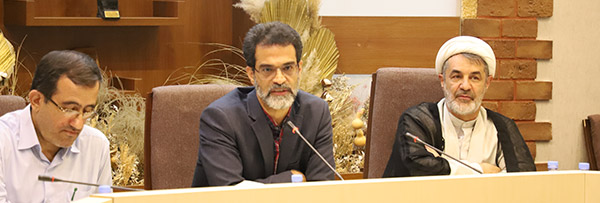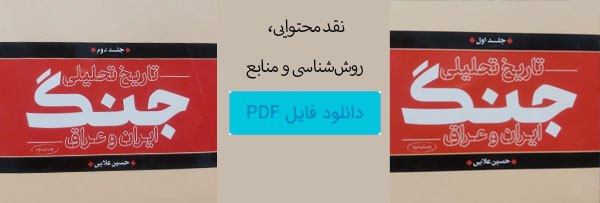Oral History News – Aban 1404
(October 23 – November 21, 2025)
According to the Iranian Oral History website, “Monthly News” is the title of a recurring series of reports published on this platform. These reports survey news items related to the site’s thematic focus as reflected in print and digital media. Below is a selection of oral-history-related news from Aban 1404 (October 23 – November 21, 2025).It was raised at the “Religious Jurisprudence and Oral History” session:
The Relationship between “Religious Jurisprudence” and “Oral History”
Challenges and Opportunities
According to the Oral History website, the first session of the preliminary meetings for the “Fifteenth Annual Oral History Conference of Iran,” titled “Religious Jurisprudence and Oral History,” was held on the afternoon of Monday, 19 November 2025, at the Andisheh Hall ...Third Regiment: Memoirs of an Iraqi Prisoner of War Doctor – 9
On September 25, 1980, along with Dr. "Naeem Abd Salman," at the head of a medical team, we set out for the command headquarters of the 20th Brigade to provide assistance. It was 4:00 PM when we drove toward the border in two vehicles carrying six passengers and a military jeep as our guide. We traveled along a rough dirt road and after 40 minutes reached the vicinity of the border point.Experts’ Answers to Oral History Questions
100 Questions/ 8
We asked several researchers and activists in the field of oral history to express their views on oral history questions. The names of each participant are listed at the beginning of their answers, and the text of all answers will be published on this portal by the end of the week. The goal of this project is to open new doors to an issue and promote scientific discussions in the field of oral history.Book Review
Pak-Setan (Clean-Seeker)
Eighteen stories from the servants and pilgrims of Arba’in from the Indian subcontinent in Sistan and Baluchestan
Pakistan, by Ehsan Qaidi Vanani, is a collection of eighteen field stories by ten authors about pilgrims from the Indian subcontinent; pilgrims who reach Iran from the borders of Mirjaveh and Rimdan to take a breather in the processions that have been organized for several ...The Role of Objects in Oral Narrative
Philosophers refer to anything that exists—or possesses the potential to exist—as an object. This concept may manifest in material forms, abstract notions, and even human emotions and lived experiences. In other words, an object encompasses a vast spectrum of beings and phenomena, each endowed with particular attributes and characteristics, and apprehensible in diverse modalities.The 372nd Night of Memoires– Part 2
At the end of September, coinciding with Sacred Defense Week, the 372nd Night of Memories was held on September 25, 2025, in the Sooreh Hall of Arts Center. The host opened the program with a warm welcome, reminding the audience that for more than thirty-three years, this gathering has kept the flame of remembrance of the warriors and martyrs alive at the beginning of every month. In this session, Haj Hossein Sadeghi Siroo’i, Hassan Naji-Rad, and Seyed Morteza ...Third Regiment: Memoirs of an Iraqi Prisoner of War Doctor – 8
Although these incidents occurred one after another, the Islamic Republic sought not to respond militarily to these provocations and acts of aggression by the Baghdad regime. The credulous public also believed that the issue would not go beyond this point and that the Iraqi government did not intend to do anything more than reclaim the occupied territories. Even Saddam Hussein himself emphasized this point in the military communiqué broadcast after the attack on September ...Experts’ Answers to Oral History Questions
100 Questions/7
We asked several researchers and activists in the field of oral history to express their views on oral history questions. The names of each participant are listed at the beginning of their answers, and the text of all answers will be published on this portal by the end of the week. The goal of this project is to open new doors to an issue and promote scientific discussions in the field of oral history.Most visited
Challenges of Interviewing in Oral History
After years of studying the theoretical foundations of oral history, conducting numerous interviews and going through their post-interview stages, as well as reading the available body of oral history literature, I was eventually given the opportunity to evaluate the edited versions of dozens of oral history projects.Comparing the Narratives of Commanders and Ordinary Combatants in the Sacred Defense
An Analysis of Functions and ConsequencesThe experience of the Sacred Defense cannot be comprehended merely through statistics or official reports; what truly endures from war are the narratives of those who stood upon its frontlines. These narratives, however, vary significantly depending on one’s position, responsibilities, and lived experience.
Unveiling of the book "Oral History: What and Why"
The First report: Alireza KamariAccording to the Oral History website, the unveiling ceremony of the book "Oral History: What and Why" by Hamid Qazvini was held on Sunday evening, November 24, 1404, in the presence of experts in the field of oral history in the Salman Farsi Hall of the Arts Center.









